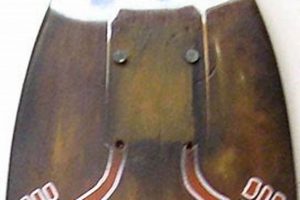The construction of a platform designed for skateboarding involves laminating multiple layers of wood veneer, typically maple, and pressing them into a curved shape. This process results in a durable and functional surface upon which a skateboarder can stand and perform maneuvers. The act encompasses selecting appropriate materials, shaping the wood, applying adhesives, and ensuring proper curing for structural integrity.
Creating a personalized riding platform allows for customization based on individual preferences and skating style. This fosters a deeper connection with the sport and offers the potential for enhanced performance through optimized dimensions and concave. Historically, the craft of making these platforms has evolved from simple wooden boards to sophisticated composites designed for specific disciplines within skateboarding.
A comprehensive understanding of material science, woodworking techniques, and design principles is essential for success in this endeavor. The following sections will explore the specific steps, considerations, and resources necessary for successful completion of this type of project.
Guidance on Crafting a Skateboarding Platform
The subsequent recommendations offer practical advice for achieving a structurally sound and functionally superior skateboarding platform. Adherence to these guidelines will contribute to a more durable and performance-oriented finished product.
Tip 1: Material Selection. Employ high-quality, consistently sourced maple veneer. The grade and density of the wood significantly impact the deck’s strength, flexibility, and longevity. Inconsistent material can lead to premature failure.
Tip 2: Grain Orientation. Strategically align the grain direction of each veneer layer. Alternating the grain provides optimal resistance to stress and prevents warping. A uniform direction will compromise structural integrity.
Tip 3: Adhesive Application. Apply a uniform and sufficient layer of waterproof wood glue between each veneer sheet. Insufficient or uneven adhesive distribution creates weak points susceptible to delamination.
Tip 4: Pressing Technique. Utilize a consistent and controlled pressing method to ensure uniform pressure distribution during the curing process. Uneven pressure can result in internal stresses and warping.
Tip 5: Curing Time. Allow ample time for the adhesive to fully cure under pressure. Premature removal from the press can compromise the bond strength and lead to future structural issues.
Tip 6: Sanding and Finishing. Employ progressive sanding techniques to achieve a smooth and consistent surface. A properly prepared surface ensures optimal adhesion for subsequent graphics and protective coatings.
Tip 7: Concave Design. Carefully consider the concave profile to suit the intended riding style. The depth and shape of the concave influence foot placement, control, and board feel.
These recommendations serve as a foundational guide to enhance the quality and performance characteristics of a handmade skateboarding platform. Careful attention to detail throughout the process is paramount.
The following section will provide insights on the customization and personalization options available for enhancing the aesthetic appeal of the finished product.
1. Veneer Selection
Veneer selection represents a foundational decision in the process of fabricating a skateboarding platform. The type and quality of veneer directly influence the deck’s strength, flexibility, and overall performance characteristics. Hard rock maple is commonly favored due to its dense fiber structure, which provides a high degree of resistance to impact and stress. Alternative wood species may offer variations in weight or flexibility, but often compromise durability. For example, using a softer wood veneer could result in a more flexible deck suitable for cruising, but it would likely be less resistant to breakage under the high-impact conditions of street or vert skating. The selection process, therefore, necessitates a clear understanding of the intended use and performance requirements of the finished product.
Further considerations include the grade and grain orientation of the chosen veneer. Higher grades of maple exhibit fewer knots and imperfections, leading to more consistent strength properties. Grain orientation, specifically alternating the grain direction in successive layers, is critical for distributing stress and preventing warping. Failure to properly consider these factors can result in a finished platform that is prone to delamination or premature failure. Commercial skateboard manufacturers often implement stringent quality control measures in veneer selection to ensure consistent product performance and minimize warranty claims. A manufacturer who prioritizes aesthetic appearance over structural integrity may select veneers with visually appealing grain patterns, even if those patterns compromise strength.
In conclusion, veneer selection is not merely a superficial choice but rather a critical determinant of a skateboarding platform’s structural integrity and performance capabilities. Informed selection based on species, grade, and grain orientation is essential for achieving a durable, responsive, and reliable finished product. Challenges in this process include sourcing consistently high-quality veneer and balancing cost considerations with performance requirements. A meticulous approach to veneer selection ultimately contributes to a safer and more enjoyable skateboarding experience.
2. Pressing Technique
Pressing technique constitutes a critical juncture in the construction of a skateboarding platform, directly influencing its structural integrity, concave profile, and overall performance characteristics. Insufficient or inconsistent pressing can result in a deck prone to warping, delamination, or compromised strength. This phase involves applying controlled pressure to a stack of laminated wood veneers, typically maple, within a mold that defines the desired shape and concave. Proper pressing ensures uniform adhesive distribution, maximizing the bond between veneer layers and creating a unified structure capable of withstanding the stresses of skateboarding. For instance, a skateboard deck subjected to repeated high-impact landings requires a pressing process that achieves optimal adhesive penetration and a void-free bond line. Otherwise, stress concentrations can lead to premature failure.
Variations in pressing technique exist, ranging from pneumatic presses to hand-operated hydraulic systems. The choice of method depends on factors such as production volume, budget, and desired level of precision. Pneumatic presses offer advantages in terms of speed and consistency, while hand-operated systems may be more suitable for small-scale or custom production. Regardless of the chosen method, maintaining consistent pressure and curing time is paramount. Deviations can lead to internal stresses within the deck, resulting in reduced pop or premature cracking. Consider the scenario of a manufacturer producing two batches of decks; one pressed with consistent pressure and cure time, the other with fluctuating pressure. The latter batch will invariably exhibit a higher rate of structural failures under identical use conditions.
In conclusion, the pressing technique represents a critical control point in the manufacturing of a durable and high-performing skateboarding platform. Understanding and implementing proper pressing procedures are essential for minimizing defects, maximizing structural integrity, and ensuring consistent product quality. The challenges associated with pressing include maintaining precise pressure control, optimizing curing times, and selecting appropriate mold designs for diverse concave profiles. Overcoming these challenges is vital for consistently producing skateboarding decks that meet the demands of modern skateboarding.
3. Adhesive Integrity
Adhesive integrity is paramount to the structural soundness and longevity of a skateboarding platform. The layered construction, reliant on bonding multiple wood veneers, makes it susceptible to delamination if adhesive bonds fail. The skateboard’s performance and safety directly correlate to the quality and permanence of these adhesive connections. For instance, a deck manufactured with substandard adhesive might exhibit premature separation of layers under the stress of aggressive riding, ultimately leading to deck failure and potential injury. The use of high-quality, waterproof wood glue, properly applied and cured, is essential for maintaining the structural integrity of the component.
The practical application of adhesive integrity extends beyond mere selection of appropriate adhesive. Careful consideration must be given to surface preparation, adhesive application technique, and curing environment. Veneer surfaces must be clean and free of contaminants to ensure optimal bond formation. Uniform adhesive distribution across the entire surface area is crucial to avoid weak points. Proper curing, including adequate pressure and temperature control, is necessary for the adhesive to achieve its maximum strength. As an example, a deck crafted using a vacuum press ensures consistent and evenly distributed pressure during the curing stage, leading to heightened adhesive integrity compared to a deck pressed using less refined methods. The quality control measures in industrial production of these components invariably include testing protocols to evaluate the strength and durability of adhesive bonds.
In conclusion, adhesive integrity is not simply a desirable attribute but a fundamental requirement for a safe and functional skateboarding platform. Compromises in adhesive selection, application, or curing invariably lead to reduced deck lifespan and increased risk of failure. The challenges faced by both amateur and professional builders lie in the selection of appropriate adhesives for specific environmental conditions, ensuring proper application techniques, and monitoring curing processes to maximize bond strength. Understanding and meticulously controlling these factors is essential for ensuring a reliable and long-lasting skateboarding experience.
4. Shape Consistency
Shape consistency is a critical parameter in skateboard deck construction, directly impacting ride quality, board feel, and trick execution. Deviations from intended dimensions or concave profiles can result in unpredictable performance and decreased control. The process of creating a skateboarding platform inherently requires replication of a specific shape and ensuring each finished unit adheres to established tolerances. Inconsistent shape undermines the board’s responsiveness and creates a disparity that seasoned skateboarders can readily detect. The effect is analogous to a musical instrument being out of tune; precise control becomes significantly more difficult. A common example of shape inconsistency is seen in mass-produced, low-cost decks where slight variations in mold pressure or material distribution lead to discernible differences in concave depth and nose/tail angles.
The importance of shape consistency extends beyond individual preference and touches on aspects of competitive skateboarding. Standardized dimensions and contours allow for consistent board feel, enabling skaters to transfer skills and tricks across different decks from the same manufacturer or with similar specifications. This predictability minimizes the learning curve associated with new boards and facilitates progression. For example, if a skater consistently practices tricks on a deck with a specific concave, switching to a deck with a markedly different shape necessitates an adjustment period, potentially hindering performance in a competition setting. Further, consistent shapes allow for efficient production and quality control. Manufacturers rely on precise molds and measurement systems to ensure that each deck meets the design specifications.
In conclusion, shape consistency is not merely an aesthetic concern but a fundamental requirement for predictable and reliable skateboard performance. Discrepancies in shape impact both novice and experienced skaters, affecting their ability to control the board and execute tricks with confidence. While slight variations may be unavoidable due to material properties and manufacturing tolerances, minimizing these deviations is crucial for maintaining product quality and satisfying the demands of the skateboarding community. The ongoing challenge lies in refining manufacturing processes to achieve tighter tolerances and ensure consistent shape across all units produced.
5. Structural Longevity
The durability and lifespan of a skateboarding platform are intrinsically linked to its structural longevity. This aspect defines the board’s ability to withstand repeated stress, impacts, and environmental factors without compromising its integrity or performance. Therefore, understanding and optimizing structural longevity are crucial considerations in the design and construction of a skateboarding platform.
- Material Composition and Fatigue Resistance
The selection of materials, particularly the wood veneer composition, directly influences fatigue resistance. Hard rock maple, known for its dense fibers, offers superior resistance to cyclical stress compared to less dense wood species. A deck constructed from inferior materials will exhibit premature fatigue, leading to decreased pop, flex, and ultimately, structural failure. The quality and grade of the veneer are therefore paramount in achieving long-term structural stability.
- Adhesive Bond Strength and Delamination Prevention
The adhesive bond strength between veneer layers is critical to preventing delamination, a common mode of failure in skateboarding platforms. High-quality, waterproof adhesives, properly applied and cured, maintain their integrity even under prolonged stress and moisture exposure. Insufficient bond strength allows layers to separate, compromising the deck’s rigidity and rendering it unusable. Effective delamination prevention ensures the deck maintains its structural integrity throughout its lifespan.
- Shape Preservation and Warping Resistance
Maintaining the intended shape and resisting warping are essential aspects of structural longevity. Warping can significantly alter the deck’s riding characteristics, affecting balance and control. Factors such as grain orientation, pressing technique, and environmental conditions influence a deck’s susceptibility to warping. Proper construction methods mitigate these effects, preserving the deck’s intended shape and ensuring consistent performance over time.
- Impact Resistance and Fracture Toughness
A skateboarding platform must withstand high-impact forces encountered during tricks and landings. Impact resistance and fracture toughness describe the material’s ability to absorb energy without fracturing or permanently deforming. Decks with enhanced impact resistance are less prone to snapping or cracking, extending their lifespan and providing a safer riding experience. Design features such as strategically placed reinforcement layers or specific concave geometries can improve impact resistance.
Optimizing structural longevity in a skateboarding platform requires a holistic approach, considering material selection, manufacturing processes, and design features. By addressing each of these facets, manufacturers and builders can create decks that withstand the rigors of skateboarding and provide a durable, reliable, and enjoyable riding experience. The pursuit of enhanced structural longevity directly translates to increased value and performance for the end-user.
Frequently Asked Questions
The following section addresses common inquiries regarding the creation of a skateboarding platform. This information is intended to provide clarity and guidance on essential aspects of the process.
Question 1: What type of wood is most suitable for the fabrication of a skateboarding platform?
Hard rock maple is widely recognized as the optimal material due to its high density, strength, and resilience. These characteristics enable the deck to withstand repeated stress and impact. Other wood species may be employed, but typically offer a compromise in durability.
Question 2: What factors contribute to the prevention of delamination in a multi-layered skateboarding platform?
The use of high-quality, waterproof wood adhesive, proper surface preparation, uniform adhesive distribution, and controlled curing conditions are all critical for preventing delamination. Ensuring a strong bond between each veneer layer is essential for maintaining structural integrity.
Question 3: How does the concave profile affect the performance of a skateboarding platform?
The concave profile influences foot placement, board feel, and control. Different concave depths and shapes cater to various riding styles and preferences. A deeper concave provides greater leverage for flip tricks, while a shallower concave offers a more stable platform for cruising.
Question 4: What role does grain orientation play in the structural integrity of a skateboarding platform?
Alternating the grain direction of each veneer layer distributes stress and prevents warping. This technique is essential for maximizing the deck’s resistance to bending and twisting forces encountered during skateboarding. Uniform grain orientation compromises structural integrity.
Question 5: What considerations are essential for achieving consistent shape across multiple skateboarding platforms?
Precision molds, controlled pressing techniques, and consistent material distribution are vital for achieving shape consistency. Deviations from intended dimensions or concave profiles can negatively impact ride quality and control. Utilizing calibrated equipment minimizes shape inconsistencies.
Question 6: How can the lifespan of a skateboarding platform be extended?
Selecting high-quality materials, employing proper construction techniques, and avoiding excessive exposure to moisture or extreme temperatures are crucial for extending the lifespan. Regular inspection for cracks or delamination allows for timely repairs and prevents catastrophic failure.
In summary, the successful fabrication of a durable and high-performing skateboarding platform requires careful attention to material selection, construction techniques, and design considerations. These factors collectively contribute to the deck’s strength, responsiveness, and longevity.
The following section will explore resources and tools available to aid in skateboard platform construction.
Build a Skate Deck
This exploration has provided a detailed overview of the process involved in “build a skate deck”, from material selection and pressing techniques to adhesive integrity, shape consistency, and structural longevity. Each element plays a critical role in the final product’s performance and durability. Neglecting any of these factors can compromise the structural integrity and reduce the lifespan of the skateboarding platform.
The craft of creating these platforms is a demanding pursuit that requires a balance of technical knowledge, precision, and dedication to quality. The ongoing innovation in materials and manufacturing processes suggests a future where even more robust and high-performing skateboarding platforms will become available. Continued refinement of construction techniques and a commitment to quality materials will ultimately drive the evolution of skateboarding equipment and enhance the skateboarding experience.







